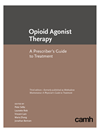Text adapted in 2023 from "Opioid Use and Opioid Use Disorders" in The Primary Care Addiction Toolkit. Available online only.
Opioid agonist therapy (OAT)
The recommended treatment for opioid use disorder is opioid agonist therapy (OAT) consisting of buprenorphine-naloxone or methadone combined with psychosocial supports. Both pharmacological options are equally effective, although there are some clinical differences related to their pharmacological properties.
Recent reviews of the evidence recommend buprenorphine-naloxone as the first-line treatment due to its superior safety profile and more flexible take-home dosing schedule compared with methadone (Canadian Research Initiative in Substance Misuse [CRISM], 2018; Centre for Addiction and Mental Health [CAMH], 2021). Methadone is the preferred option for patients who request this medication, who do not respond to buprenorphine-naloxone or who have high opioid tolerance, especially due to fentanyl use.
Third-line treatment options are specialist-led approaches such as slow-release oral morphine and supervised injectable opioid agonist therapy with diacetylmorphine or hydromorphone, which is recommended for patients who have not responded to or do not have access to buprenorphine-naloxone or methadone (Selby et al., 2022).
Opioid antagonist: Naltrexone
Another treatment option, naltrexone, is an opioid antagonist that blocks the effects of opioids and prevents relapse in patients who are no longer dependent on opioids. However, its effectiveness is limited due to poor medication adherence. Oral naltrexone is not recommended except for a very limited population such as for people who are highly motivated or legally mandated to receive treatment (e.g., safety-sensitive workers such as health care professionals, police, firefighters) (American Society of Addiction Medicine [ASAM], 2020). The extended-release injectable naltrexone formulation may improve adherence; however, it is not available in Canada to treat opioid use disorder.
Rationale for OAT to treat opioid use disorder
A large body of research shows that methadone and buprenorphine are highly effective treatments for opioid addiction. They increase treatment retention, support abstinence, improve health and social functioning, and reduce morbidity and mortality associated with opioid use disorder (ASAM, 2020; Bruneau et al., 2018; CAMH, 2021; CRISM, 2018). In appropriate doses, methadone and buprenorphine:
- suppress symptoms of opioid withdrawal for the full 24-hour dosing interval
- reduce opioid cravings
- do not cause sedation or euphoria
- block the euphoric effects of other opioids.
Considerations before initiating OAT
- Document discussions about the benefits, risks, side effects and duration of OAT. Ensure that patients understand the risk of opioid withdrawal with sudden discontinuation of OAT, as well as the need for re-initiation after a prolonged period of missed doses.
- Review expectations of OAT, including frequency of pharmacy visits, clinical assessments and urine drug testing.
- Educate patients about safe storage and disposal of medication when they qualify for take-home doses.
- Consider developing a treatment agreement that outlines the above considerations and that is signed by you and the patient.
Structure of OAT
Patients on methadone or buprenorphine initially take their medication daily under the supervision of a pharmacist. Patients who are psychosocially stable and have stopped opioid and other problematic substance use after a certain period can receive take-home doses based on schedules outlined in clinical guidelines.
Urine drug testing (UDT) is another key component of OAT. It is part of a comprehensive assessment when OAT is initiated and can be used during treatment to monitor adherence and response to treatment, as well as illicit substance use. The frequency of testing varies from weekly during the stabilization phase to every one to three months if the patient is clinically and socially stable on OAT (CAMH, 2021). Prescribing guidelines vary, so physicians should know the policies in their province or territory on take-home doses and monitoring, including UDT.


